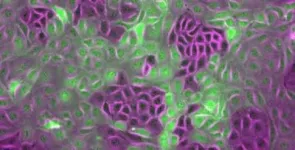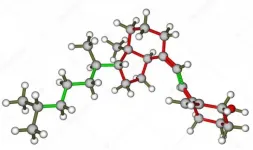Hubble celebrates 31st birthday with giant star on the edge of destruction
2021-04-23
(Press-News.org) The giant star featured in this latest Hubble Space Telescope anniversary image is waging a tug-of-war between gravity and radiation to avoid self-destruction. The star, called AG Carinae, is surrounded by an expanding shell of gas and dust -- a nebula -- that is shaped by the powerful winds of the star. The nebula is about five light-years wide, which equals the distance from here to our nearest star, Alpha Centauri.
The huge structure was created from one or more giant eruptions several thousand years ago. The star's outer layers were blown into space, the expelled material amounting to roughly 10 times the mass of our Sun. These outbursts are typical in the life of a rare breed of star called a Luminous Blue Variable (LBV), a brief unstable phase in the short life of an ultra-bright, glamorous star that lives fast and dies young. These stars are among the most massive and brightest stars known. They live for only a few million years, compared to the roughly 10-billion-year lifetime of our own Sun. AG Carinae is a few million years old and resides 20 000 light-years away inside our Milky Way galaxy. The star's expected lifetime is between 5 million and 6 million years.
LBVs have a dual personality. They appear to spend years in semi-quiescent bliss and then they erupt in a petulant outburst, during which their luminosity increases -- sometimes by several orders of magnitude. These behemoths are stars in the extreme, far different from normal stars like our Sun. In fact AG Carinae is estimated to be up to 70 times more massive than our Sun and shines with the blinding brilliance of 1 million suns.
Major outbursts such as the one that produced the nebula featured in this image occur a few times during a LBV's lifetime. A LBV star only casts off material when it is in danger of self-destruction. Because of their massive forms and super-hot temperatures, luminous blue variable stars like AG Carinae are in a constant battle to maintain stability. It's an arm-wrestling contest between radiation pressure from within the star pushing outward and gravity pressing inward. This arm-wrestling match results in the star's expanding and contracting. The outward pressure occasionally wins the battle, and the star expands to such an immense size that it blows off its outer layers, like a volcano erupting. But this outburst only happens when the star is on the verge of coming apart. After the star ejects the material, it contracts to its normal (large) size, settles back down, and becomes stable again.
LBV stars are rare: fewer than 50 are known among the galaxies in our local group of neighbouring galaxies. These stars spend tens of thousands of years in this phase, a blink of an eye in cosmic time. Some are expected to end their lives in titanic supernova blasts, which enrich the Universe with the heavier elements beyond iron.
Like many other LBVs, AG Carinae remains unstable. It has experienced lesser outbursts that have not been as powerful as the one that created the present nebula. Although AG Carinae is semi-quiescient now, its searing radiation and powerful stellar wind (streams of charged particles) have been shaping the ancient nebula, sculpting intricate structures as outflowing gas slams into the slower-moving outer nebula. The wind is travelling at up to 1 million kilometres per hour, about 10 times faster than the expanding nebula. Over time, the hot wind catches up with the cooler expelled material, ploughs into it, and pushes it farther away from the star. This "snowplough" effect has cleared a cavity around the star.
The red material is glowing hydrogen gas laced with nitrogen gas. The diffuse red material at upper left pinpoints where the wind has broken through a tenuous region of material and swept it into space. The most prominent features, highlighted in blue, are filamentary structures shaped like tadpoles and lopsided bubbles. These structures are dust clumps illuminated by the star's light. The tadpole-shaped features, most prominent at left and bottom, are denser dust clumps that have been sculpted by the stellar wind. Hubble's sharp vision reveals these delicate-looking structures in great detail.
The image was taken in visible and ultraviolet light. Hubble is ideally suited for observations in ultraviolet light because this wavelength range can only be viewed from space.
INFORMATION:
More information:
The Hubble Space Telescope is a project of international cooperation between ESA and NASA.
Each year in the month of April, ESA/Hubble uses the telescope's anniversary as an opportunity to develop special initiatives to engage and involve the public in this annual milestone. You can explore all of the ESA/Hubble 31st Anniversary initiatives that have been and will be announced here: END
[Attachments] See images for this press release:

ELSE PRESS RELEASES FROM THIS DATE:
2021-04-23
How do the billions of cells communicate in order to perform tasks? The cells exert force on their environment through movement - and in doing so, they communicate. They work as a group in order to infiltrate their environment, perform wound healing and the like. They sense the stiffness or softness of their surroundings and this helps them connect and organize their collective effort. But when the connection between cells is distrubeddisturbed, a situation just like when cancer is initiated, can appear.
Assistant Professor Amin Doostmohammadi at the Niels Bohr Institute, University of Copenhagen has investigated the mechanics of cell movement and connection ...
2021-04-23
Etrasimod 2 mg treatment group achieved statistical significance in the percentage change in weekly peak pruritis (PP-NRS), in the change in Dermatology Life Quality Index (DLQI), and in the change in Patient-Oriented Eczema Measure (POEM)
Etrasimod 2 mg was generally well tolerated, consistent with data in previous trials
Park City, Utah, April 23, 2021 - Arena Pharmaceuticals, Inc. (Nasdaq: ARNA) today announced data at a late-breaking session at the American Academy of Dermatology VMX Experience. Etrasimod, a novel investigational drug candidate to treat moderate-to-severe atopic dermatitis (AD), demonstrated statistical significance in both clinician and patient reported outcomes in the ADVISE Phase 2b clinical trial. Etrasimod is a highly selective, once-daily, oral sphingosine ...
2021-04-23
Paper Title: Safety of Tranexamic Acid in Hip and Knee Arthroplasty in High-risk Patients
Journal: Anesthesiology
Authors: Jashvant Poeran MD, PhD, Director of the Center for Clinical and Outcomes Research, and Associate Professor of Population Health Science & Policy and Orthopedics at the Icahn School of Medicine at Mount Sinai; Calin S. Moucha, MD, Chief of Adult Reconstruction & Joint Replacement Surgery at Mount Sinai Hospital, and Associate Professor of Orthopedics at the Icahn School of Medicine at Mount Sinai; and other coauthors.
Bottom Line: The use of the drug tranexamic acid is commonplace in patients undergoing hip or knee replacement surgery to reduce blood loss. However, this drug works by promoting clotting and safety concerns exist when used in certain high-risk ...
2021-04-23
By Karina Toledo | Agência FAPESP – Can a high dose of vitamin D administered on admission to hospital improve the condition of patients with moderate or severe COVID-19? The answer is no, according to a Brazilian study published in the Journal of the American Medical Association (JAMA).
The article reports a randomized, double-blind, placebo-controlled clinical trial, the kind of study considered the gold standard to evaluate drug efficacy. It was conducted with FAPESP’s support by researchers at the University of São Paulo’s ...
2021-04-23
DURHAM, N.H.-- Corals and sponges are important foundations in ocean ecosystems providing structure and habitats that shelter a high number of species like fish, crabs and other creatures, particularly in the seamounts and canyons of the deep sea. Researchers at the University of New Hampshire have discovered that when it comes to climate change not all deep-sea corals and sponges are affected the same and some could be threatened if average ocean temperatures continue to increase in the deep sea of the Northwest Atlantic.
"These deep-sea corals and sponges are ecologically important because they are foundational ...
2021-04-23
ITHACA, N.Y. - House finches are locked in a deadly cycle of immunity and new strains of bacterial infection in battling an eye disease that halved their population when it first emerged 25 years ago, according to new research from the Cornell Lab of Ornithology.
House finch eye disease causes red, swollen, watery or crusty eyes. Afflicted birds can recover, but may die because they cannot see well enough to find food or avoid predators. The latest analyses, based on the observations of Project FeederWatch participants from eight Northeast states, addresses the long-term ...
2021-04-23
A recently published article in the Molecular Plant-Microbe Interactions journal provides new evidence that pathogens are hijacking the plant immune system to cause disease while providing insights into a newly discovered mechanism.
A large variety of pathogens infect plants and cause different diseases, which can lead to reduced crop yields. During infection, pathogens secrete effector proteins into the plant cell. Some of these proteins target plant proteasomal degradation machinery, which is responsible for recycling proteins to regulate cell processes. Some E1, E2 and E3-ligase proteins have been identified as playing a role in plant susceptibility ...
2021-04-23
PHILADELPHIA, PA - The first National Institutes of Health (NIH) National Cancer Institute (NCI)-funded clinical study examining stereotactic body radiotherapy (SBRT) in the treatment of oligometastatic breast, prostate, and non-small cell lung (NSCLC) cancers displayed evidence that SBRT can be safely used to treat patients who have multiple metastases. These results were recently published in JAMA Oncology.
The results of the Phase I NRG-BR001 trial, conducted by the NCI National Clinical Trials Network group NRG Oncology, indicate that SBRT treatment in ...
2021-04-23
SAN FRANCISCO, CA--April 22, 2021--In their effort to understand the very earliest stages of life and how they can go wrong, scientists are confronted with ethical issues surrounding the use of human embryos. The use of animal embryos is also subject to restrictions rooted in ethical considerations. To overcome these limitations, scientists have been trying to recreate early embryos using stem cells.
One of the challenges in creating these so-called synthetic embryos is to generate all the cell types normally found in a young embryo before it implants into the wall of the uterus. Some of these cells eventually give rise to the placenta. Others become the amniotic sac in which the fetus grows. Both the placenta and the amniotic sac are crucial for the survival of the fetus, and defects ...
2021-04-23
A new research paper examining the relationship between the Omega-3 Index and risk for death from any and all causes has been published in END ...
LAST 30 PRESS RELEASES:
[Press-News.org] Hubble celebrates 31st birthday with giant star on the edge of destruction



